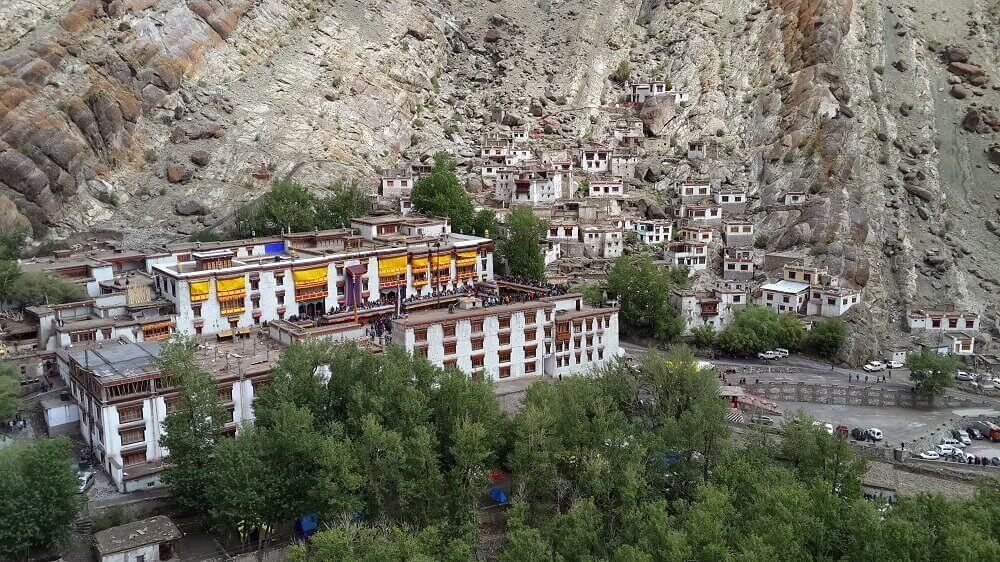
Top 10 Buddhist Monasteries in Ladakh- A Blissful Experience
Ladakh is not just about natural beauty; its culture is as beautiful as the landscape. And to know about Buddhist culture of Ladakh one must take a visit to monasteries of Ladakh. Here people have thrived and gone, civilizations came and then destroyed but the monasteries they have seen it all.
And these monasteries are still standing tall as Ladakh is witnessing the huge inflow of tourists. So, while you are on a tour to Ladakh, make sure you visit few of these ancient monasteries and interact with lama’s to gain some insight into Buddhism.
Here is the list of Monastries that you should visit while travelling to Ladakh.
1. Hemis Monastery:
Hemis Monastery lies about 40 km towards the south-east of Leh city. It is the largest as well as the wealthiest monastery in Ladakh. Monastery holds a day-long annual festival called Hemis Tsechu which is held during summers. This festival is also known as Hemis festival and is a major tourist attraction. The major attraction of the festival is a holy masked dance performed by resident lamas of the monastery. The monastery has beautiful paintings and a statue of Lord Buddha, which are the highlights too.
Best time to visit Hemis Monastery is June-July.
2. Thiksey Monastery:

Thiksey Monastery is located around 20 Kms from Leh city. It is one of the most beautiful monasteries in the whole of Ladakh. It resembles Potala Palace in Lhasa, Tibet. This 12 storey monastery has 10 temples. The main attraction of Thiksey monastery is 49 ft statue of Maitreya Buddha (future Buddha) seated on a lotus, it covers almost two floors of the monastery. Monastery has a large collection of ancient statues, books, paintings, stupas and sword.
3. Spituk Monastery:
Spituk Monastery is situated around 8 Kms from Leh City overlooking the mighty Indus River. Spituk is home to 100 monks as well as a giant statue of goddess Kali, which is shown to the public during the yearly Spituk festival.
4. Alchi Monastery:

Alchi monastery is located in Alchi village around 70 Kms from Leh city. It is monitored by Likir Monastery. It is one of the oldest monasteries of Ladakh and different from others monasteries, this monastery is built on flat land instead of on a hilltop. The Monastery comprises of three sections- Dukhang, Sum-tsek, and the temple of Manjushri.
5. Diskit Monastery:

Diskit Monastery, also known as Diskit monastery is the oldest and the largest Buddhist Gompa in the Nubra Valley, Ladakh. The monastery has a statue of Cho Rinpoche (Crowned Buddha) in the prayer hall. The 32 meters. high statue of Maitreya Buddha overlooking the vast Nubra Valley is another major attraction at Diskit Monastery.
6. Lamayuru Monastery:

Lamayuru Monastery is located at a distance of 125 Kms from Leh on Srinagar-Leh highway. It is one of the oldest monasteries in Ladakh. It is believed to be built around the same time as Alchi Monastery.
7. Likir Monastery:

Likir Monastery is located around 53 Kms from Leh city. It is quaintly situated on a little hill in the valley in Likir village near the Indus River about 9 Kms off Srinagar-Leh Highway. The museum of the monastery has the wide collection of Buddhist relics and artefacts.
8. Stakna Monastery:

Stakna Monastery also known as Tiger’s Nose is located around 25 Kms from Leh city. It is situated just beside the hill on the banks of Indus River. Stankna Monastery offers breathtaking views of Indus valley. It was built in the late 16th century.
9. Phyang Monastery:

Phyang monastery is located on a hilltop around 15 Kms from Leh town. It was built in the early 16th century and belongs to red hat sect of Buddhism. The museum of monastery houses ancient wall paintings, collections of idols, scriptures, Chinese, Tibetan and Mongolian firearms and weapons.
10. Phugtal Monastery:

Phugtal Monastery or Phugtal Gompa (often referred as Phuktal) is located in the remote Lungnak Valley in south-eastern Zanskar. It is one of the only few Buddhist monasteries in Ladakh that can still be reached only by foot. The location of the monastery on the mouth of cave gives it the distinct identity and serves a major attraction as well. This isolated monastery is built of mud and wood. Reaching the monastery by trekking is an enriching experience.



